Denon AVR-X3800H Reviewed at $1,699.00
Product Name: Denon AVR-X3800H
Product Description: 9.4 CH 8K AV Receiver
-
Design - 8.8/10
8.8/10
-
Audio Quality - 9.4/10
9.4/10
-
Inputs / Ports - 9.3/10
9.3/10
-
OS, Apps and Features - 9.4/10
9.4/10
-
Price / Quality - 9.3/10
9.3/10
Summary
Reviewed at $1,699.00
Pros
- Excellent performance
- Dolby Atmos, DTS:X, IMAX Enhanced and Auro-3D
- Six 40Gbps HDMI 2.1 inputs
- Future Dirac Live support
Cons
- Same old design
- No front HDMI input for one more year
- No composite or component ports
- Higher price than previous years
Cheapest Places to Buy :
*We are a reader-supported website. When you buy through links on our site, we may earn a small affiliate commission at no extra cost to you. Home Media Entertainment does not accept money for reviews.*
Not too long ago Sound United announced new 2022 AV receivers for both their Denon and Marantz brands and recently we had the chance to get a taste of their new Denon AVR-X2800H which was an overall minor upgrade over the 2020 AVR-X2700H. But today in our Denon AVR-X3800H review we will be looking at their second release for this year and from the looks of it, this one is far more interesting considering the changes they did compared to its predecessor, the AVR-X3700H.
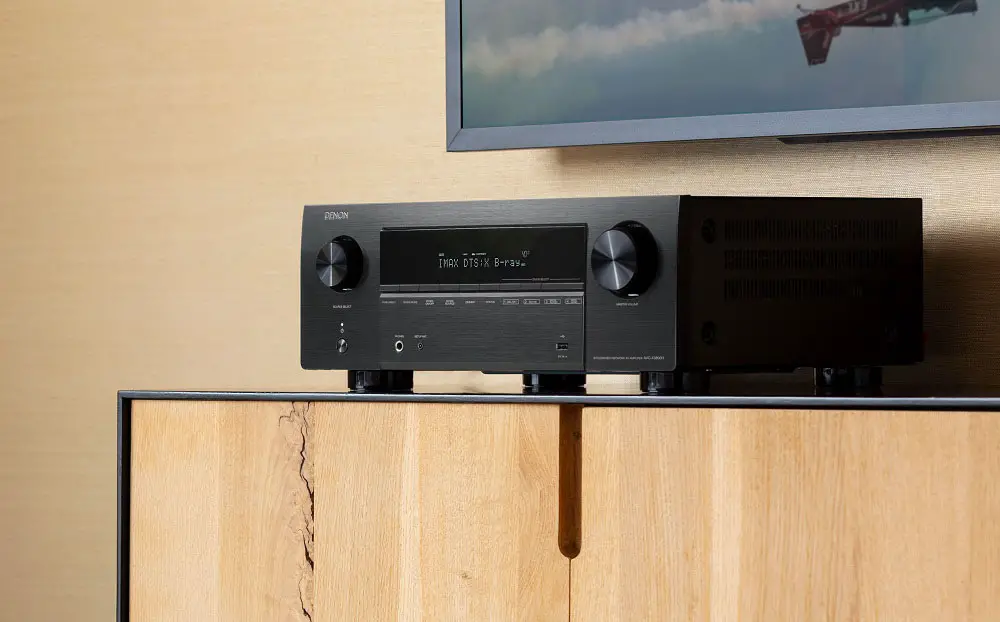
The X2800H only added three 40Gbps HDMI 2.1 ports and a refreshed user interface . On the other hand the list of changes or upgrades on the X3800H is so extensive that makes the new 2022 model feel like a completely new unit rather than a yearly release as the X2800H was. We will go over the details in each dedicated section but first of all let’s see real quick what the X3800H is all about.
This is an AV receiver with 9.4 channels of built-in amplification and 11.4 channels of processing capable of 105 watts per channel. It supports a huge list of audio formats and technologies including Dolby Atmos, DTS:X, IMAX Enhanced, Auro-3D, 360 Reality Audio and MPEG-H Audio along with the usual virtual and up-mixing tech like Dolby Surround, DTS Neural:X, Dolby Atmos Height Virtualization and DTS Virtual:X.
We also get Audyssey MultEQ XT32 along with future upgrades for Dirac Live support, 4 independent subwoofers outputs, High Resolution Audio, HEOS technology, AirPlay 2, voice control, custom integration, bi-amp capabilities, multi-room zones, Bluetooth Audio Transmission, Advanced Pre-Amplifier Mode, six full 40Gbps HDMI 2.1 ports and HDMI upscaling.
There are so many existing and newly added features, audio formats and technologies that is hard to include everything in a single paragraph. It seems that Denon really outdid themselves with the X3800H in terms of how many features they managed to cram into the system. On paper the X3800H surely looks more than impressive so let’s analyze everything and determine if indeed their new release is as good as it seems.
Design
The X3800H may add a whole lot of new features but if one thing remains the same is the looks and design for both the main unit and the remote it comes with. And to be honest we find this a bit strange considering that sister brand Marantz went through a major design overhaul this year. If this is a prelude of what we will see for Denon units in the future remains to be seen.
Dimensions wise it seems that the X3800H is like for like with the X3700H meaning that what we have here is a medium sized AV receiver measuring 17.1″ x 15.3″ x 9.3″ (434 x 389 x 236 mm) but as always the height can be lowered to just 6.6″ (167 mm) if you turn the antennas horizontally which doesn’t have any noteworthy effect on the AV receiver’s signal quality. Its weight is also the same at 27.6 lbs (12.5 kg) which is the standard for its size and category.
In terms of actual looks being a Denon receiver will definitely not get it any awards for design. Featuring straight lines and sharp corners this is your typical black box receiver that sounds much better than it looks. The front, as in most Denon receivers, features a brushed metal texture with an exact same layout as we saw in the last few years.
The front display sits prominently at the top center of the front face with two big circular knobs at each side for volume on the right and source selection on the left. Under the source selection knob we find the power button with a tiny LED light above it while a thin line under the central display houses 10 function buttons that include tuner and zone 2 controls, Dimmer, Status and four quick selection buttons. No change here whatsoever.
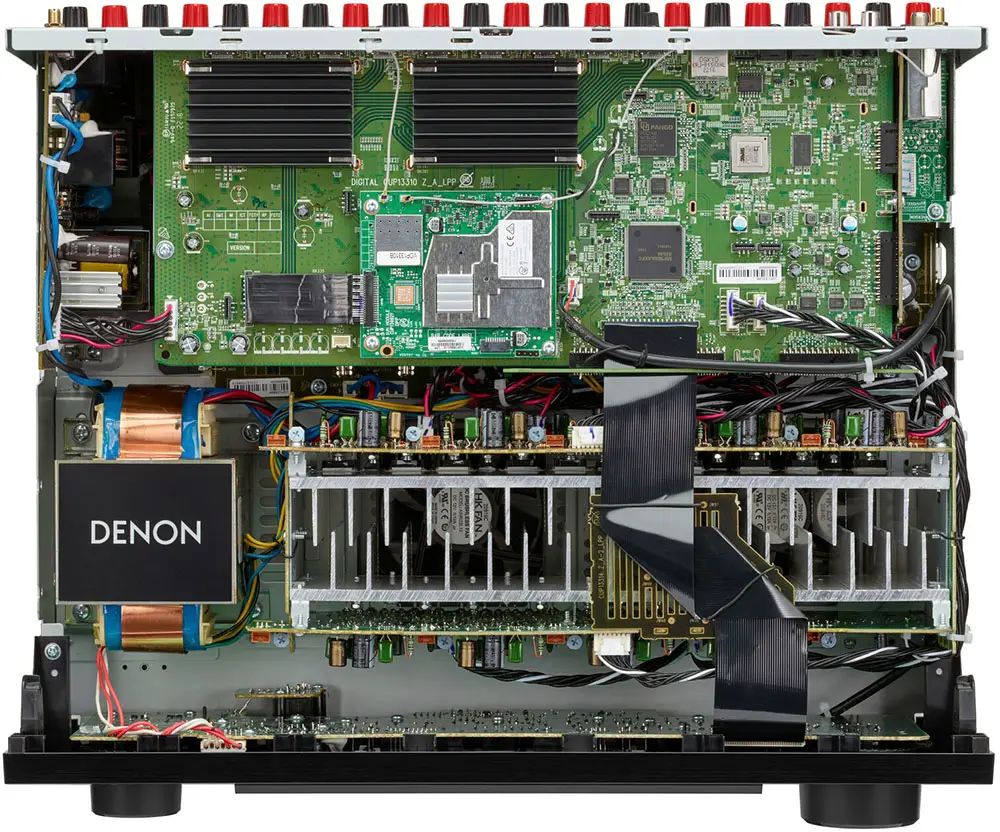
Under these buttons we find some front ports with the headphones jack and setup microphone port on the left and a single USB port on the right that can be used to stream audio from a USB based external storage like a flash drive. As was the case with the X2800H, the front HDMI port is still missing in action. There are plenty of HDMI inputs at the back but the front one gives great convenience and practicality and we strongly hope Sound United will bring it back in future releases.
Looking under the hood we find several similarities but also a few distinct differences. The receiver features discrete high-current amplifiers on all channels with low-impedance drive capability, but where it differentiates itself from its predecessor is in the DSP and DACs the new one uses.
While the X3700H was using AKM AK4458 32-bit D/A converters along with two sets of powerful DSP (Digital Sound Processor) chips for decoding and sound processing the X3800H goes for a single 2-core SHARC Griffin Lite XP DSP in combination with TI (Texas Instruments) 32-bit/192kHz digital-to-analog converters. The change in DACs was necessary as the fire in the AKM factory some time ago forced many manufacturers to opt for different DACs until production would resume to normal levels.
As for the remote, this is exactly the same one we used in the X2800H. It is very similar to previous Denon receivers but is not entirely the same as it seems there are some minor changes in the 2022 version. Code named RC-1253 the remote comes in the same color and design as previous ones and the changes we find here is the different position of the sleep button, a bit different layout of the input buttons and the addition of the HDMI OUT which allows you to quickly change the HDMI output in use. Everything else remains the same.

It comes with all the input buttons at the top along with the HEOS and Bluetooth functions, navigation buttons in the middle along with channel and volume controls while playback, quick selection and sound mode buttons are being placed at the bottom.
The remote is not bad but there is certainly room for improvement. Having the same design for many years now the Denon remotes feel outdated and old style and we would like Denon to update them along with the design of the unit itself. Also movement sensing backlight should be a must by now as many remotes start to get this which is an amazing practical feature to have. And when you pay such a premium price such a feature should be standard.
Not much to say here. Denon needs to take lessons from Marantz and finally refresh their design as it looks a bit too old for today’s standards. In terms of hardware we do get that many consumers are upset with the change of the DACs but what many should ask is if there is no real world audible difference does it really matter? Because instruments and numbers may indicate the change, but it’s our ears that are the judges and if what we hear is good enough for the money we spend then why all the fuss?
Audio Quality
Next we will be looking at all the audio formats the receiver supports and here we find a few interesting updates. With the standard first, the receiver supports the usual Dolby Atmos and DTS:X object oriented audio tracks but along with these we get support for up-mixing and virtual technology features in order to cover all needs and specific room configurations.

When it comes to up-mixing tech we find the usual Dolby Surround and DTS Neural:X. What these up-mixing tech are doing is to up-convert stereo and legacy mixes in order to make use of all the speakers you have in your setup. As for virtual tech the Dolby Atmos Height Virtualization and DTS Virtual:X are capable of creating sounds that originate from virtual created speakers around your room where there are no physical speakers present.
This virtual tech obviously is not as good and accurate as having real physical speakers and are very much room dependent. Also the sound many times can be heard very over-processed something we were never very fond of.
We also get IMAX Enhanced support, which we saw in the X3700H for the first time, but these are not all as the X3800H gets even more. First Denon decided to bring Auro-3D which up until last year was kept only for the higher tier receivers. Then we also get Sony’s 360 Reality Audio which the receiver can support by connecting a 360RA streaming device via HDMI.
And lastly there is support for MPEG-H codec which has started to be used extensively for broadcasting. It is already being used with ATSC 3.0 in South Korea and over DVB in certain European countries while it is used in several streaming services for powering their 360 Reality Audio music. So from the looks of it the MPEG-H format will become more and more popular over the coming years making the X3800H future proof in this regard.
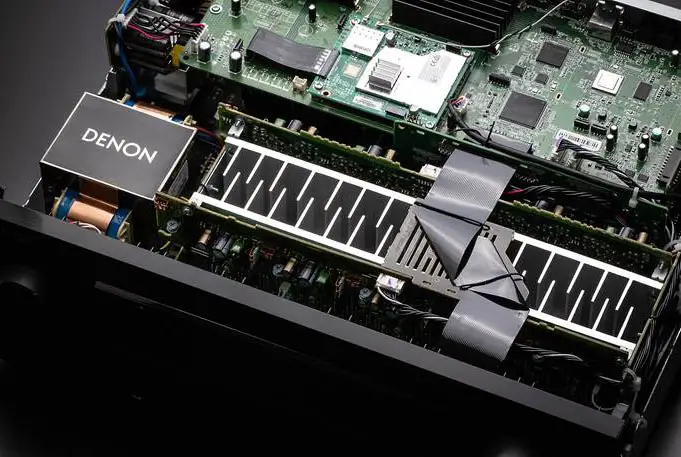
The X3800H comes with 9 channels of built-in amplification and each channel can pump 105 watts of power (8 ohm, 20 Hz – 20 kHz, 0.08% 2ch drive). Keep in mind that this is only for 2 channels driven meaning that when all 9 channels are active this number goes down considerably. You also have the ability to go all the way to 11 channels but for that you will need an external amp to drive the last two channels. No changes here.
But what has really changed is that the X3800H has the ability to drive four subwoofers independently instead of two that was previously possible. Multi-subwoofer setups are very common among home theater fans and it seems that Sound United took notice of this. As such the inclusion of four outputs allows for immense control over the kind of setup you want to create.
With the built-in amplifiers you can go all the way for a 5.4.4 channels audio setup with four dedicated overhead speakers for maximum immersion. But for our test we went for a much more modest 5.1.4 setup using a single subwoofer and 4 height speakers placed at the front and back of our viewing area.
For this review we opted to try out Star Wars: The Force Awakens in 4K UHD with its class leading Dolby Atmos mix. Just for the record, our Panasonic UHD player was connected to the Denon and from there to the TV itself.
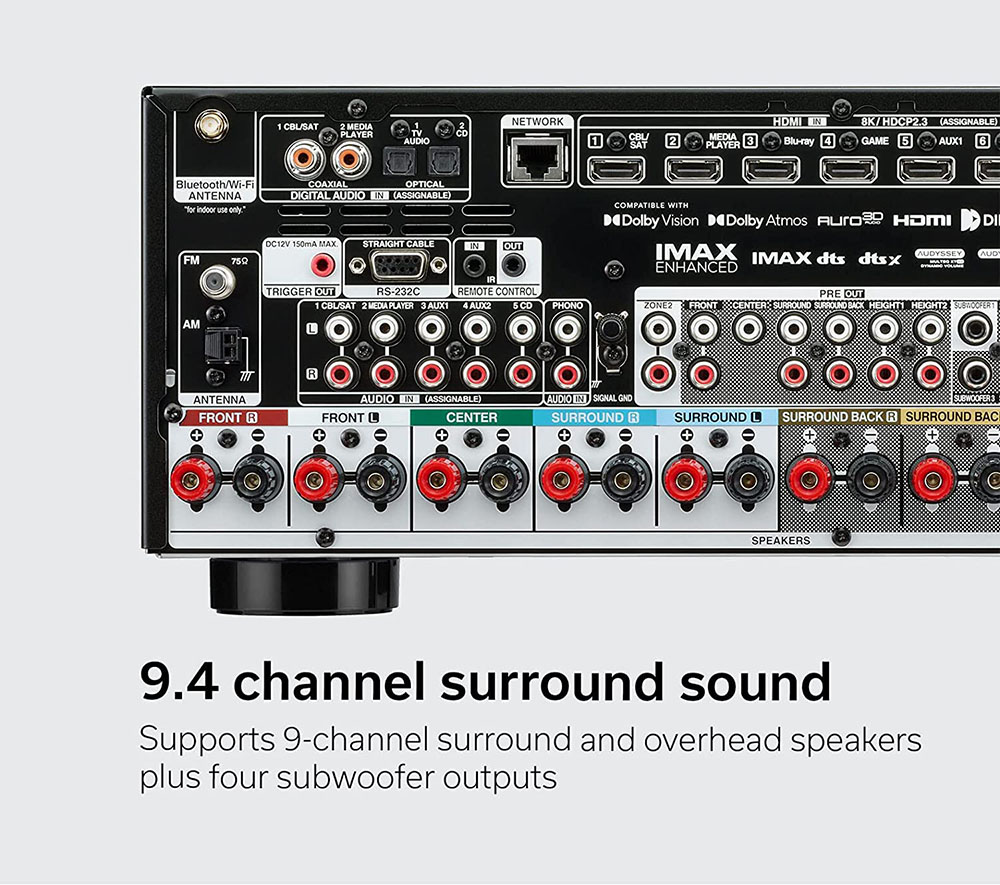
So what you can expect from the X3800H? We don’t know if there is any actual difference in audio tonality and overall sound output but to our ears we got the usual characteristic Denon treatment. The X3800H does not stray from what has made Denon famous in this market and surely continues from where the previous release left off.
Star Wars is obviously a film with plenty of scenes that can show what an AV receiver is capable of and the Denon was able to flex its muscles through every scene we tried out.
The front sound wall was impressive with nice expansion in all axis. There was enough depth in order to fill the entire space between the front speakers and our viewing position and surely we didn’t feel any dead spots in between. If you make sure to calibrate the unit correctly it will certainly not disappoint you.
The Denon was very capable at keeping the center channel at the middle isolated from the other front outputs. Even during action filled scenes all dialogue was clear and distinct and we didn’t feel the need to up the center channel volume at all.
As for the two main channels, surely these did all the heavy lifting, as always, and you could sense the various panning effects like blasters, laser fire and Tie Fighters travelling from one side of our room to the other. Really impressive indeed.
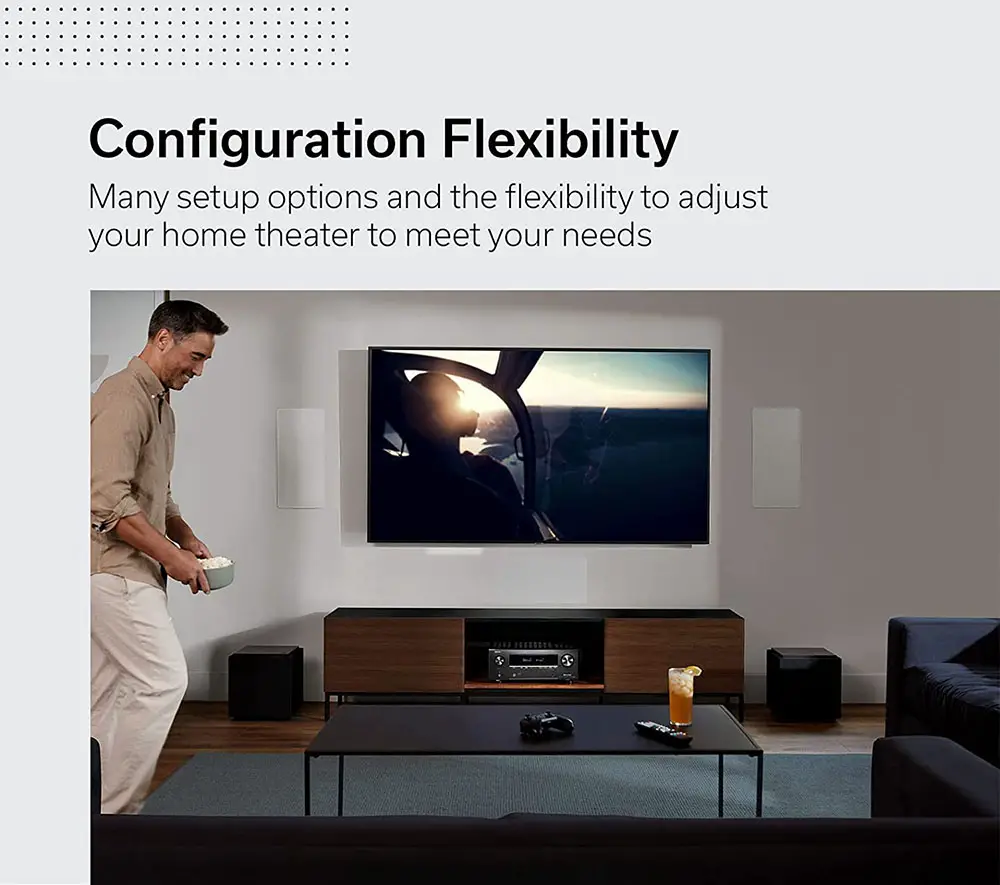
Equally impressive was its surround performance. The battle on Takodana was a very good scene that showcased nice discreet action both behind and above us. The surrounds blended nicely with the front in order to create a very immersive 360 degrees bubble around us.
With four Atmos channels active the overhead layer was equally impressive as the surrounds. Star Wars is not shy of panning effects and spaceships flying past our heads felt more realistic than ever. The four height speakers made sure to create pinpoint accuracy and good clarity to the Atmos effects without ever being too much on your face but rather making the whole mix feel more alive and vibrant.
Another area where the Denon did not disappoint was its bass performance. Obviously the kind of subwoofer you will use plays a detrimental role here but the Denon made sure to pass all low end information to our sub in order to give us an Earth shaking experience. Explosions would send low end waves to our face while spaceships would make our walls tremble like they were really passing overhead.
The X3800H has enough juice to crank up the volume high enough without introducing any bothering compression. For large rooms obviously you will have to go for a bigger AV receiver but for small or mid-sized areas this one can do great either you are subtle on the volume knob or like to get the neighbors angry.

Overall the X3800H is no different than many other Denon AV receivers we had tried before. At least to our ears the unit had all the same qualities and characteristics of this brand with spacious sounds, very good channel separation, pinpoint accuracy in space and realistic overhead and surround activity that bind perfectly with what was emitted at the front, making it an ideal piece of equipment for any home theater system.
High Resolution Audio has become the standard in these receivers so except from the usual low quality MP3, WMA and AAC the unit can also playback FLAC, ALAC and WAV files up to 192 kHz / 24-bit as well as DSD for both 2.8 and 5.6 MHz. In our case, as we always do in our reviews, we selected a few music tracks in FLAC format that we streamed through the USB port of the receiver for the best possible quality.
Last part of our tests is music so we switched to a 2 channels setup and got some songs to see what the X3800H can do with it and if there is any substantial change in its output compared to other Denon receivers from previous years.
Once again the X3800H proved to be a very stellar performer. As always this is not supposed to replace a dedicated music setup but considering the cost and how much such a system can be priced the Denon can stand proud of its signature sound and quality output.

Vocals and all high end sounds had a lot of emotion and high energy to them, the mid-range was stable, nicely handled and smoothly balanced while the bass had good weight, nice tempo and plenty of punch. Even with bass intensive songs the Denon kept everything under control without showing signs of fatigue or instability.
Going through various genres the X3800H handled all of them with great success. We couldn’t detect any signs of abnormality in any specific genre and the unit proved that it may be home theater immersion where it really excels at but it can bring any kind of music performance to completion with noteworthy quality.
Overall in terms of pure sound performance you will get your usual Denon quality of sound. In real world content you will not be able to distinguish any differences from previous years and if there are any in reality you will not be able to tell. The X3800H is an amazing AV receiver and proved to be a proud continuation of the X3X00H series so far.
Ports and Connectivity
Next we will looking at the all the connectivity options and ports available in the new unit. Design of the X3800H may not have changed at all but when it comes to its inputs there are some noteworthy changes we need to talk about.
First of all we already mentioned above about the frontal ports that include the Headphones jack, the setup microphone port and the USB port. The front HDMI input is missing for one more year but we can always hope this will come back at some point.
At the lower back we get the usual 11 speaker terminals that are placed in a straight line which helps a lot with cable management. The terminals are the usual quality we have seen from Denon so all is good here with good quality plastic caps but if you want to use the full 11 channels you will need an external amplifier for the last two channels.
At the top we find all the HDMI ports and it seems that we actually have a reduction in their numbers at this year there are only six instead of seven HDMI ports that were available in the X3700H. Six are still plenty so the small reduction will surely not have such a great impact on the unit overall.
As for everything else we get 1 Ethernet port, 2 coaxial and 2 optical digital audio inputs, 11.4 channels pre-outs, 5 analogue audio inputs and one more dedicated for phono, a remote control input and one more output, an RS-232C port for control, a single 12 volts trigger output and the usual FM/AM antenna inputs along with the WiFi/Bluetooth connectors.
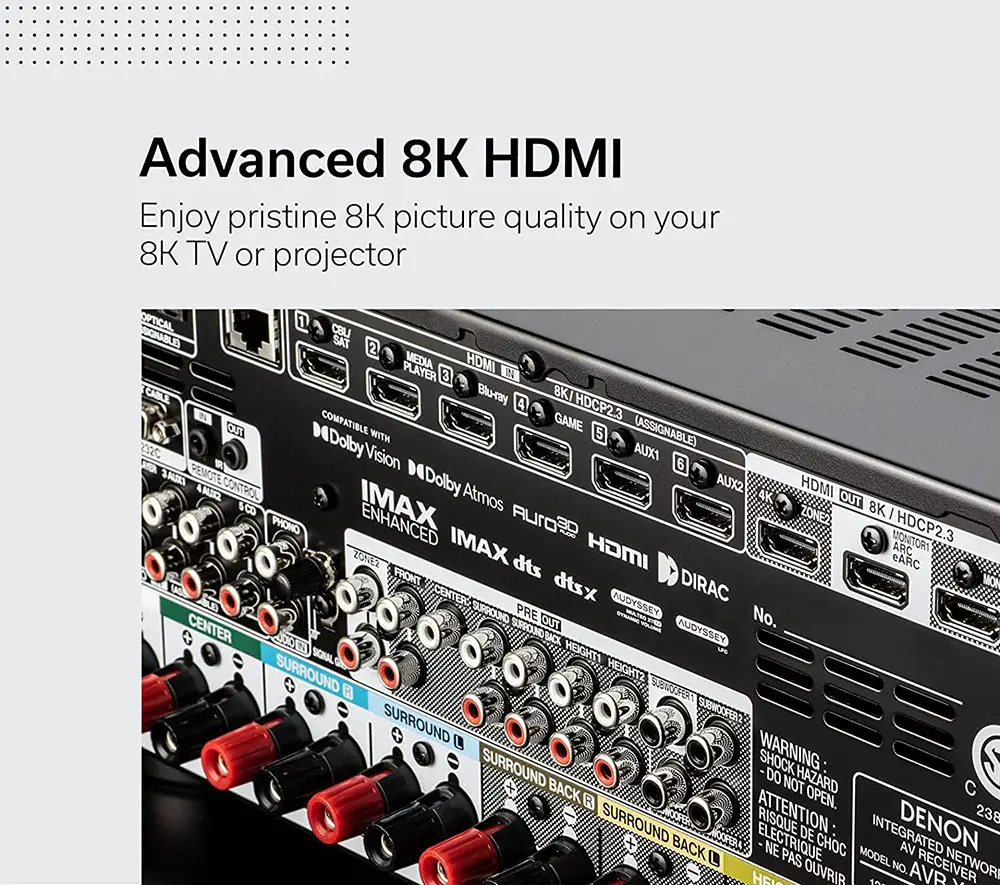
The changes we get in the X3800H compared to last year are basically three. The six HDMI ports are all full 40Gbps HDMI 2.1 ones, there are four independent subwoofer ports this time while all component and composite ports have been taken out completely. For this last one we are not sure if it is actually a good or a bad thing but as we move further along into the digital age where the HDMI ports are the prevalent way of connecting all equipment these old analogue ports seem to be a bit out of place.
As for its HDMI ports the X3800H comes with six updated HDMI 2.1 ports that support all the old and new exciting technologies including 8K/60Hz and 4K/120Hz video passthrough with 40Gbps bandwidth, Deep Color, x.v. Color, HDR10, HDR10+, Dolby Vision, Hybrid Log-Gamma (HLG), Dynamic HDR, 3D, Quick Media Switching (QMS), Variable Refresh Rate (VRR), Auto Low Latency Mode (ALLM), Quick Frame Transport (QFT), Fixed Rate Link (FRL), ARC, eARC, Auto Lip Sync and HDMI-CEC.
All the 2020 AV receivers that featured HDMI 2.1 ports came with a bugged Panasonic chip that wouldn’t allow it to pass certain signals, like 4K/120Hz RGB signals from the Xbox series X for example, as it would result in a black screen.
The AVR-X3800H on the other hand seems to be using updated HDMI 2.1 hardware which allows up to 40Gbps of bandwidth in all of its HDMI ports and this includes all the signals with a 4K@120Hz configuration including Xbox Series X.
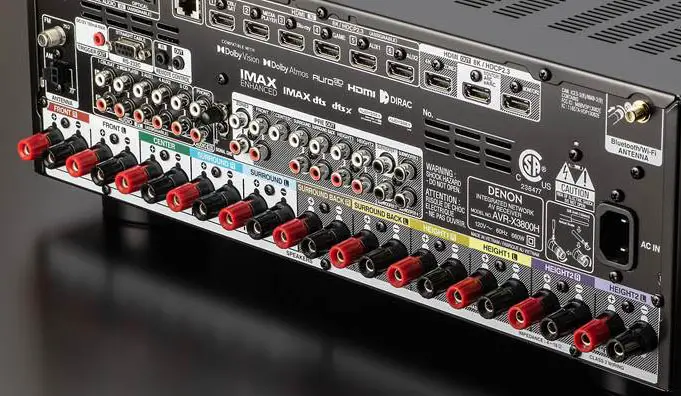
Although we have tried this in some of our other reviews, just for making sure, we did connect our Xbox Series X in our TV through the X3800H and we got a trouble free 4K@120Hz signal with VRR enabled. We didn’t notice any problems during testing. Both the signal and the HDMI handshaking with the TV were stable during our session.
As for the unit’s wireless capabilities we get built-in WiFi which can connect both in 2.4GHz and 5 GHz networks while it seems we get a minor upgrade here, as was the case with the X2800H also, as its WiFi is now able to support up to IEEE 802.11a/b/g/n/ac.
The X3800H has a lot going for it. The six fully working HDMI 2.1 ports and the addition of four independent subwoofer ports are surely the highlights of the new unit. Taking our the composite and component ports may feel like an omission but for such a premium unit we do not believe it will have a great impact in the unit’s overall value.
OS, Apps and Features
Denon receivers always came with an extensive list of functions and features and the X3800H seems to have managed to add a few more no matter how surprising this may seem.
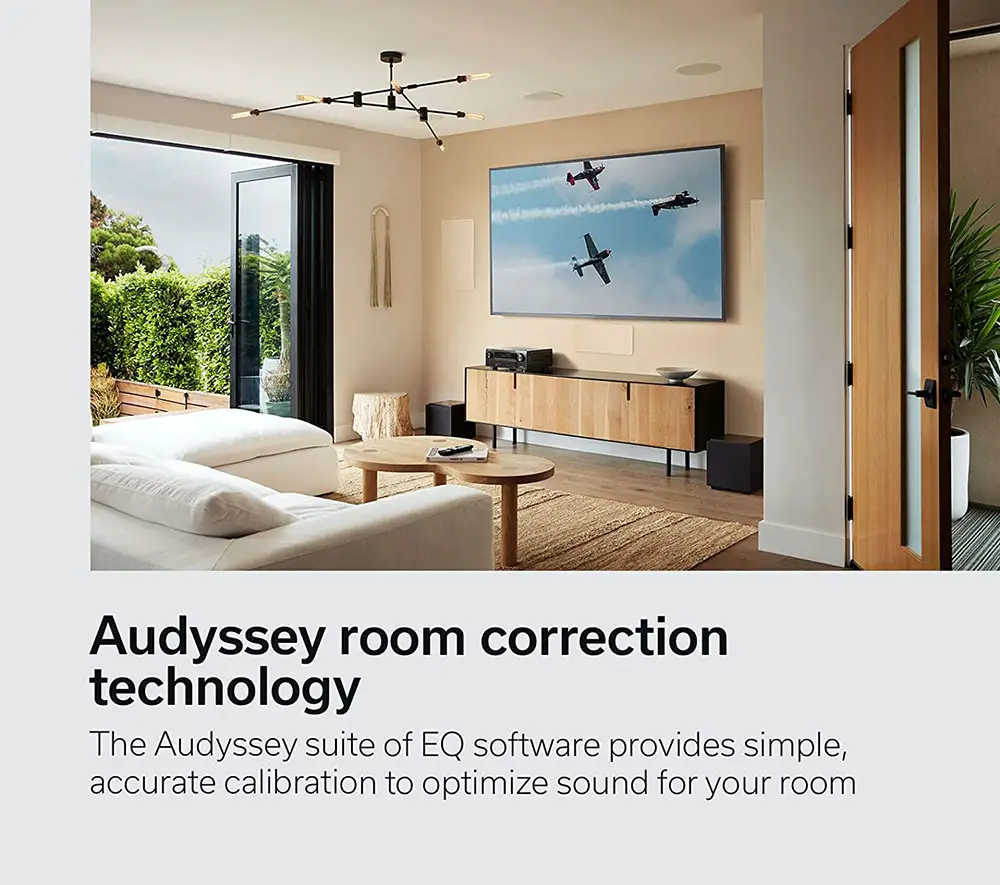
But first of all we will talk about the audio calibration system. Denon is once again using the Audyssey system and as with all manufacturers they scale it accordingly to meet the price and performance standards of each of their models. For the X3800H we get the Audyssey MultEQ XT32 version which is their best and most feature complete suite. In comparison this one features the highest resolution filters which can result in higher accuracy during calibration.
The Audyssey MultEQ XT32 also comes with Dynamic Volume, Dynamic EQ, Audyssey LFC and Audyssey sub EQ HT. This version of Audyssey has the ability to analyze up to 8 different listening positions with the help of the included microphone and creates precise digital filters in order to offer the best audio result for your particular space.
But except from the core system we also get Dynamic EQ which is a feature that is responsible for keeping the clarity and dynamic levels of audio even when you like to watch at low volume, like for night viewings for example. Dynamic Volume on the other hand is capable of balancing sudden changes and spikes in volume that could appear when there are sudden changes from TV broadcasting to commercials.
There is also Audyssey LFC that uses advanced psychoacoustic algorithms to deliver more full-range balance, including deep bass, without disturbing neighbors or people in other rooms of your home and lastly Audyssey Sub EQ HT that provides individual DSP tailoring of each subwoofer in a multi subwoofer setup for deeper bass with improved definition.
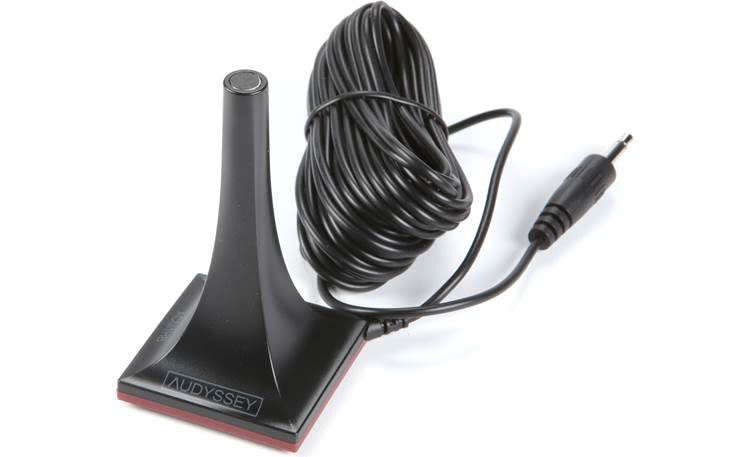
Going through the Audyssey calibration can be done either through the built-in wizard or if you want to dive deeper into calibrating your system then you can download the Audyssey MultEQ Editor app that is available for Android or iOS and do a more thorough setup with the help of your mobile device.
Only keep in mind that this app has a one time fee which is a shame to be honest when you already pay such a high price for the receiver. As for the built-in system, this is more than enough for most casual users as it offers almost everything you need to make very good and precise adjustments to your system.
Now here we need to mention a new addition, and a rather major one we might say, to the X3800H and this is the inclusion of Dirac Live. Dirac Live is an audio calibration system that is included in the new unit and will become available in spring of 2023. From that moment you will be able to choose either the free Audyssey system that will work out of the box for every unit or buy a Dirac Live license for more advanced tuning.
The Dirac Live availability will be completed in two steps. The first one, as we mentioned, will roll in spring 2023 with the availability of the room correction feature in two packages, the limited or full bandwidth, while the second phase will come sometime in 2024 with additional bass control management for a single subwoofer or multiple ones. Sound United has announced the prices for all packages and according to them these are dictated by Dirac themselves.

Stay tuned as we will try Dirac Live when it will become available as this surely is one of the most requested features in the last few years and it seems that finally Denon will deliver.
Now, Denon provides another app for this AV receiver and this one comes completely free. The Denon AVR Remote app, as it is called, lets you control the unit with your mobile device through a nice visual interface. If you are tired of the included remote this is a nice and most important free alternative. The app is available for both Android and iOS devices so we suggest you give it a try to see if you like it.
Another change we find this year in the new refreshed UI. For some years now we were complaining about how old style and outdated the UI of the Denon AV receivers looked. It was as though it belonged in the early 2000s with its simple menus and 480p resolution.
It seems that Denon finally listened to our cries and decided to update the looks of it. The menus are not all that different in terms of structure and layout. You still get the same list of features in a similar way to the old UI but they bumped the resolution up to 1080p and made it look graphically more pleasing to the eye. Now it feels like it is something newer and although it may not be as fancy as what smart TVs have it is far better that what we were getting till now.

As for the rest, the receiver comes with the usual streaming as well as multi-zone capabilities that Denon includes in almost all their units. As it supports both HEOS and Airplay 2 you can either stream music online from one of the available online streaming services that include Spotify Connect, Pandora, Amazon Music HD, TuneIn, Deezer, SiriusXM and TIDAL among others or create your own multi-room environment with the use of appropriate wireless speakers.
Both the HEOS and Airplay 2 apps are available for downloading from their appropriate stores for use with your mobile device. But if you prefer a wired connection the AVR-X3800H also supports Zone 2 through its dedicated pre-outs or one of the HDMI outputs available at the back of the unit.
Now as far as streaming, online is not the only option you have as you can stream audio from a network drive or NAS server if it happens you to have one connected to your local network. Also with the included USB port you can stream music through some connected external storage or flash drive.
Lastly if you prefer a more wireless way of streaming your music there is Bluetooth available for connecting with your mobile device. If you use Apple devices then Airplay 2 can also be used to stream music wireless through it.
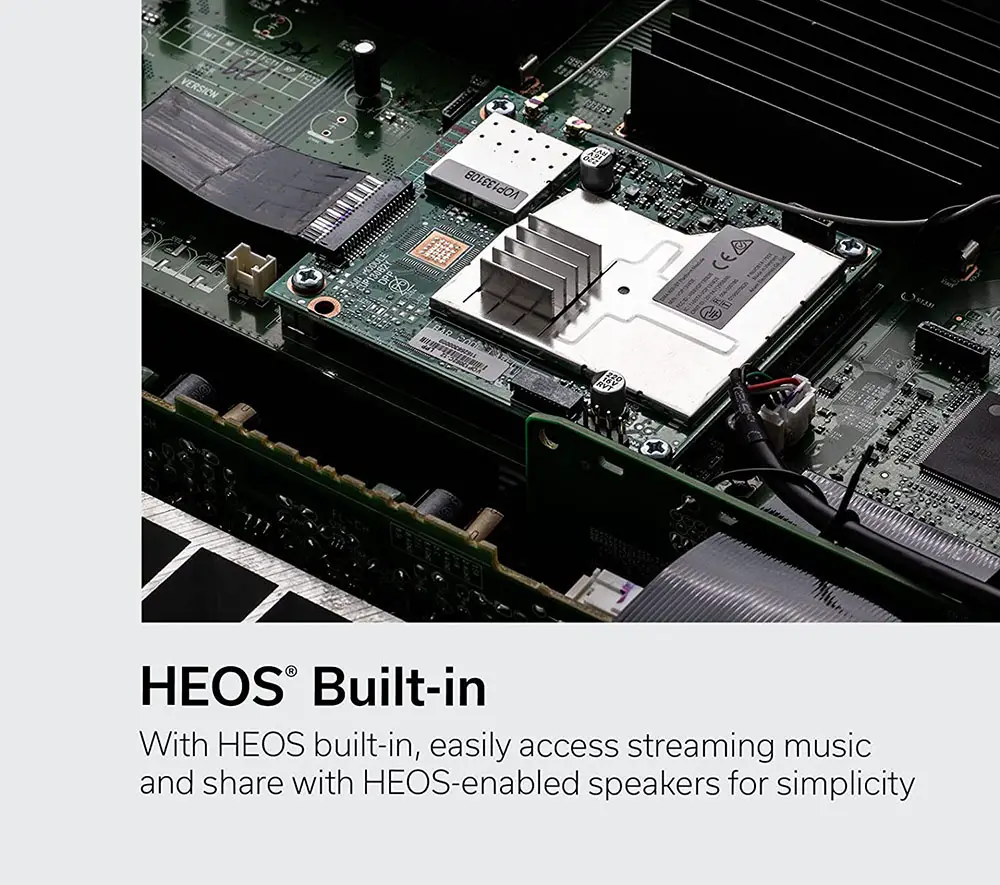
And since we mentioned Bluetooth another function that is included in the X3800H and seems to become a standard is that the receiver can output audio in two different ways using its Bluetooth transmitter. The X3800H is capable of streaming audio to Bluetooth enabled headphones for a completely silent house experience or it can also output sound from both its speaker terminals and to a Bluetooth headset. This can be particularly practical in case there is a member in the family that is hearing impaired.
But keep in mind that this can be used only for music and not for movies. And this happens because the Bluetooth transmitter of the AV receiver is using only the SBC codec and not some more advanced variant meant for such use, like aptX Low Latency. As a result there is bound to be an audio delay due to the Bluetooth transmission speed making this feature ideal only for music use.
Denon is known for including all known voice control platforms to most of their models and the X3800H is not any different in this regard. As such there is support for both most known ones with Amazon Alexa and Google Assistant but there is also support for Apple’s Siri through the Airplay 2 app and the advanced automation system Josh.ai making this receiver feature complete in this regard.
Another handy feature that we do find is HDMI-CEC and this one lets you use the TV remote to control the AV receiver if the TV also supports this. You can understand the practicality of this as this way you can reduce the amount of remotes you will need to have in your home theater. Obviously this feature lets you use only the most basic functions of the receiver but for everyday use it can be a very time saving one.
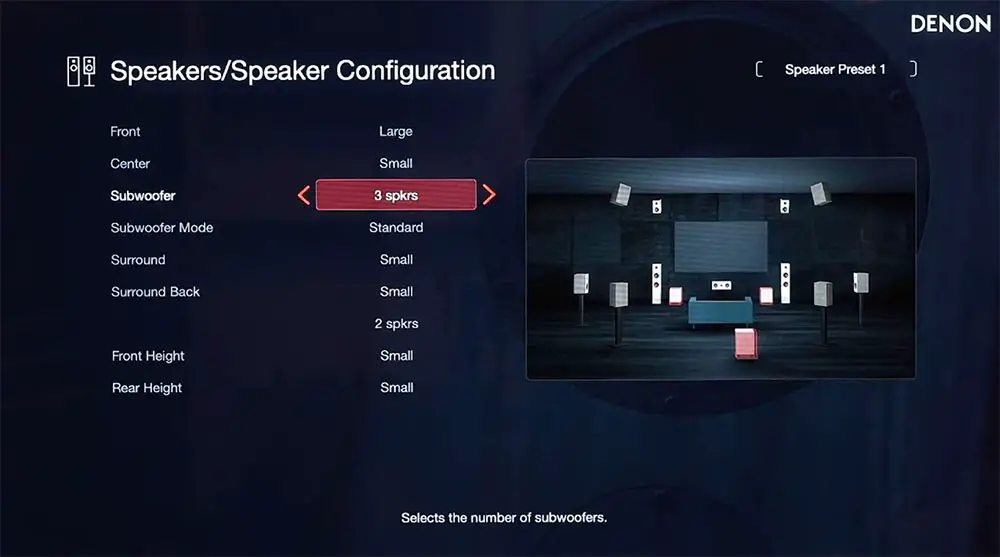
There are even more extras and features available so we will try to name as many of them as we can. The receiver supports video upscaling to 8K resolution but the obvious limitation here is that the X3800H can do that only through its HDMI ports as all analog ports are taken out. We also get an ECO mode that can regulate the receiver’s power usage for a more environmental friendly power consumption as well as being “Roon Tested” certified.
For this last one there seems to be a bit of confusion as there are two types of certifications. Roon Ready and Roon Tested. The AVR-X3800H, as with all Denon AV receivers, is Roon Tested which means while Roon will work on this unit you will not get the highest quality possible. So for example if you use Airplay, audio quality is limited to 16 Bit/44.1kHz. Keep that in mind in case Roon is specifically important to you but you also want your files to be streamed in their original quality.
Lastly we get an upgrade to a previous included feature and this is the Pre-Amplifier mode which is now called Advanced Pre-Amplifier mode. With it your Denon AV receiver works as a perfect AV pre-processor with the latest HDMI connectivity.
Pre-Amplifier Mode provides a cleaner signal path and more tolerance in clipping level by disconnecting internal amplifiers. The difference this year with the Advanced version is that you can choose how many channels you want to disconnect from the main unit and as a result you can add various external amplifiers in the future according to your needs.

Final Thoughts
The X2800H may have been slightly underwhelming but the X3800H more than made up for it. The X3700H was already a very stellar release and looking at its feature list you wouldn’t think that Denon would be able to add much more to it. But oh boy, did Denon took us by surprise.
The new AVR-X3800H brings everything the X3700H had and added Auro-3D, 360 Reality Audio and MPEG-H Audio support, Dirac Live with a future update in 2023, six full 40Gbps bandwidth HDMI 2.1 ports, support for four independent subwoofers, a new updated 1080p resolution user interface, an updated Pre-Amplifier mode to support specific usage of channels and a minor update to its WiFi module.
As for its downsides, these are mostly minor ones compared to the value that we do get with this unit. Denon took out all composite and component ports which is something that some consumers may not be very pleased to hear. Also we still miss the front HDMI port while the Audyssey MultEQ Editor app is not free which is unacceptable if you ask us. A refreshed design of both the main unit and the remote would be nice as it has become old over the many years it has been used while its price has gone up compared to the retail price of the X3700H.
The Denon AVR-X3800H is surely a major upgrade over what previous yearly releases offered. It may not be perfect as no audio device is. But Denon made sure to include so much value to it that even the higher retail price is not enough to disappoint. This is a serious piece of equipment and can definitely take your home theater experience to the next level.
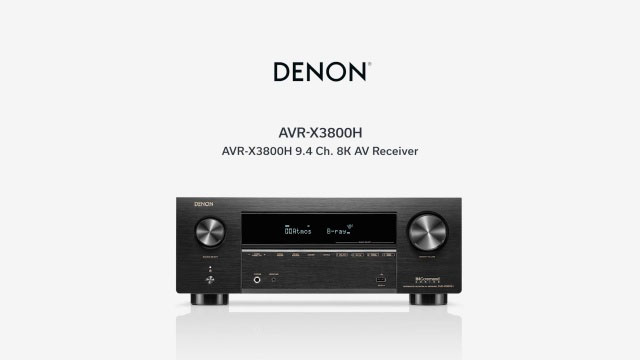
For more reviews you can check our dedicated 9 channels 8K AV Receiver reviews list or even look at our Product Reviews Table where you can find the brand and specific product you are looking for.
Cheapest Places to Buy :
*We are a reader-supported website. When you buy through links on our site, we may earn a small affiliate commission at no extra cost to you. Home Media Entertainment does not accept money for reviews.*
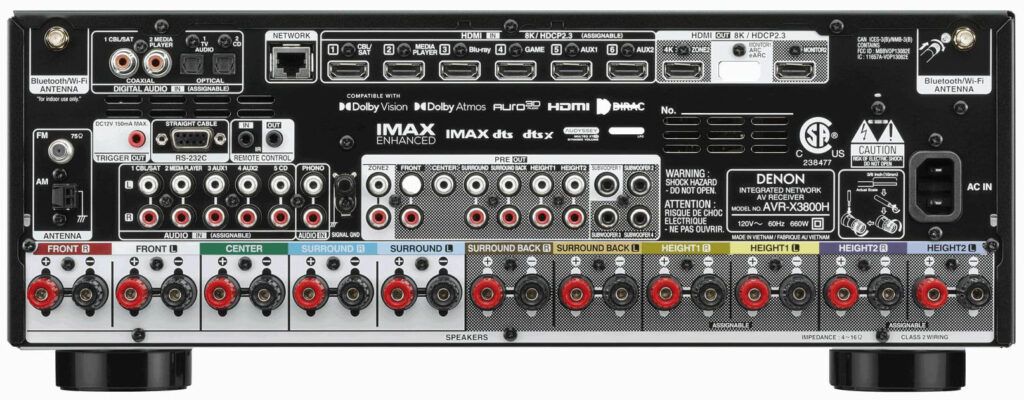
I am vaguely familiar with the X3700H. But the price difference between the 2 models is a hard pill to swallow.
I wonder how hard would it be for them to put an HDMI port on the front. There are times when you could use a front HDMI port for convenience. Also 105 watts of power are good enough but the drop-off when you go beyond 2 channels is a little disappointing.
The big question I have is, “is it worth the investment?”.
Hey Mike. It is always a question if it worth the investment. I believe that the X3800H is worth it. Denon added a lot of things this year that makes the price increase a bit easier to accept.
Now this is what I am talking about. They really added a lot in the X3800H this time although the price does leave a sour taste in the mouth. These things have become very expensive to be honest. I will probably for the X3800H but I will wait until I can find some interesting discount on it first.
Indeed most electronics have become more expensive this year. Unfortunately this is something we will have to live with. But discount will surely happen at some point even for these new releases so you keep looking.
I was browsing for Denon home cinema amps today, and saw that the new models don’t come with component! This is a no go! What the hell Denon! At least a component in, to allow conversion from component to hdmi. At this price range there are no excuses for such shortcomings!
Hello Marco. It seems that a lot of brands, and not only AV receivers and amps specifically, are phasing out their analog ports. I have seen a lot of new TV models also taking out all component and composite ports, either premium or not, so this is something not only Denon is doing. I have seen this happening slowly the last couple of years and it seems that soon most home theater electronics will be with digital ports only.
Hello Stratos, I’ve seen a lot of adverse comments regarding this new AV receiver, among them Armin from audiosciencreview https://www.audiosciencereview.com/forum/index.php?threads/denon-avr-x3800h-review.38574/page-75
that says the SINAD is too poor : what do you think?
Thanks per advance
Phil
Hello Phil. I am aware of that forum topic and Amir’s measurements. I will tell you what I believe…
I will not judge his work and how he takes these measurements but my advice to you is not to get stuck too much in these diagrams and measurements. Even if he is correct what really matters is the end result and if this supposedly poor performance can reach your ears. If it was me, from what I heard with the X3800H, I would have no hesitation to go buy it. You really are not going to understand the difference compared to previous releases.